
SALEM, Ohio — If farming is in your blood, you can’t run from it. Rodger Sharp, owner of Rodger Sharp Sheep Farm, learned that lesson about midway through his agricultural endeavor.
Raised on a dairy farm, Sharp is no stranger to farming, and is even more familiar with the ever-present face of change.
Sharp went to college to become a pilot, something he thought would get him away from the farming world, and it did for a little while — he was deployed in Iraq and Afghanistan as an Air Force pilot in a C130 aircraft. But while he was gone, his future was unfolding at home.
During his deployment, he learned that three sheep had been purchased as 4-H projects for his then-young sons at home. After his initial shock wore off, he and his family started to take the sheep business seriously, and now with the boys grown and a few years experience under their belts, those three 4-H lambs turned into more than 250 head of commercial sheep on their Columbiana County farm.
Sharp dove into sheep farming with a dairy frame of mind. He says that many sheep farmers tend to be slow to adopt new technology, but dairy farmers stay more current with their production practices.
Among the innovations he’s adopted, is a handling system based on a Scottish design. The system is much like those used for cattle, just downsized to fit the needs of the sheep. The sheep come into the crowd pen and work their way up the slow curve of the chute alley to a squeeze chute where Sharp can administer medications, vaccinations and check the sheep’s overall health. The sheep then continue on to a set of scales and foot bath during certain times of the year. With constant improvements to the system, Sharp can now work all 250 sheep through the chute in 45 minutes or less.
(Story continues below slide show.)
Rodger Sharp pasture feeder
Perched on a pasture hill sits a wooden feed trough, a simple design that Rodger Sharp enjoys because it makes things easy to manage.
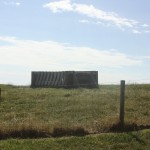 View
View
Rodger Sharp pasture feeder
Perched on a pasture hill sits a wooden feed trough, a simple design that Rodger Sharp enjoys because it makes things easy to manage.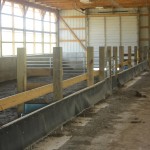 View
View
Rodger Sharp sheep barn
In Rodger Sharp's new barn, modified dairy-style feed alleys line the center aisle. Here, the sheep are fed corn silage, among other things, and can enjoy automatic waterers and controlled ventilation.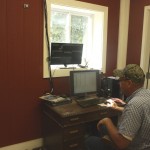 View
View
Rodger Sharp office
Technology plays a large role on Rodger Sharp's Columbiana County sheep farm. Shown here is Sharp's Radio Frequency Identification (RFID) reader and computer system, which lets him quickly scan through records.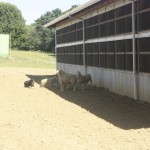 View
View
Rodger Sharp sheep barn
Rodger Sharp's new sheep barn, built last year, is a bit unconventional, and is complete with curtains on both long sides, like a dairy barn.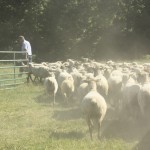 View
View
Rodger Sharp sheep flock
With the help of the dogs, Columbiana County sheep producer Rodger Sharp can move the sheep through the pastures with ease. Here, the flock follows Sharp through a gate and into a new pasture with Bo the Border Collie bringing up the rear. (Haley Drake photo)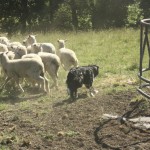 View
View
Rodger Sharp Border Collie
With his Border Collies, Rodger Sharp can herd his flock from pasture to pasture and through his working area. Without them, he says herding would be much more difficult. (Haley Drake photo)RFID use
One of Sharp’s goals in farming is not to make things harder than they need to be, so he uses Radio Frequency Identification (RFID) tags in each of his sheep.
“There are non-producers in every flock,” said Sharp, explaining RFID tags help determine who the “thieves” are and who isn’t quite pulling his weight.
When working the sheep through the chute, he can scan their ear tag with his RFID reader and record their weight, vaccinations given, health status, and any other information that he would like to record. That information is then transferred to a computer system in the barn office, where Sharp can comb through records while watching his flock on a screen connected to various cameras throughout the farm.
New additions
The barn that houses the office was built just last year and resembles more of a freestall-type dairy barn than a sheep barn. Curtains line two of the walls, and long, dairy-style feed bunks run down the middle alley.
The barn is surrounded by pastures, planted with a mixture of grasses and legumes. In addition to forage, Sharp feeds corn silage, something that isn’t used on many sheep farms. But, Sharp says, sheep are ruminants just like cattle. If cattle can eat it, why can’t sheep?
Marketing
Along with the goal of keeping things simple, Sharp strives to market and manage his sheep wisely. Each year, he culls 20 percent of the herd and adds 25 percent, all in an effort to get bigger and better. Awareness of customer preferences also drives Sharp’s marketing decisions. Ethnic populations are his typical market, so he raises sheep that will best fit their needs. His sheep are typically about 80 pounds at sale, and time of year drives the market, so Sharp tries to market them before May 1 and during the fall when prices are at their highest.
Man’s best friend
Technology and constant advancements are surely a part of Sharp’s success, but when it comes to the basics, he says he couldn’t do it without his dogs. Bo, a one-year-old Border Collie, along with one other female and a pup in training, herd all of the sheep with just a few simple commands.
Ohio Sheep Day
Because of Sharp’s innovative practices, he has been selected to host this year’s Ohio Sheep Improvement Day July 9, with registration beginning at 8 a.m. The farm can be found at 27735 Winona Road, Salem, Ohio.
The event is open to the public, although onsite registration is required. Registration, which includes lunch, is $15 for OSIA members and $25 for nonmembers. Memberships are available for purchase at the time of registration.
The Sheep Improvement Day will focus on some of Sharp’s record-keeping practices as well as his progressive view on sheep farming. Other sessions are planned throughout the day.
For questions regarding the Ohio Sheep Improvement Day, contact Roger High, executive director of the Ohio Sheep Improvement Association at 614-246-8299 or by email at rhigh@ofbf.org.









